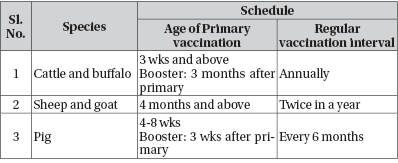
Ebibeni Ngullie1, Bhaskar Bora2 and Anamika Sharma3
- SMS (Animal Science), KVK, Dimapur
- SRF, NICRA
- PC, KVK Dimapur
It is a highly contagious viral disease of cloven footed animals viz. cattle, buffalo, sheep, goat and pigs. In India, foot and mouth disease (FMD) continues to be the most wide spread viral disease affecting bovines as well as small ruminants, and the economic loss due to FMD is tremendous that occurred due to death of young animals, marked reduction in milk yield, abortion in advance stage of pregnancy and reduced working ability of drought animals, decline in quality of meat, reduction in fertility and poor quality of semen in breeding bull etc. The diseases also restrict the possible export of livestock and livestock products in the overseas.
Epidemiology
Out of the possible seven, only four serotypes, e.g., ‘O’, ‘A’, ‘C’ and Asia 1 were ever recorded in India. It has been recorded that about 85% of the outbreaks of FMD in India are caused by serotype ‘O’, followed by ‘A’, which account for about 8 to 10% and the rest due to Asia 1. Generally, type ‘O’ has been comparatively more active in North Eastern Hill Regions of the country.
Sources of virus
- Incubating and clinically affected animals
- Breath, saliva, faeces, urine and milk, and in semen (up to 4 days before showing any clinical sign)
- Meat and by-products in which pH has remained above 6.0
- Carriers: particularly cattle and water buffalo; convalescent animals and exposed vaccinates (virus can persists in the oropharynx for up to 30 months in cattle or longer in buffalo, 9 months in sheep)
- As compare to other species, infected pigs produce enormous quantities of virus with over a hundred million infectious virus particles exhaled per day. Consequently, pigs are often referred to as the “amplifier hosts” of FMD.
Transmission
- Airborne, especially in temperate zones (up to 60 km over land and 300 km by sea)
- Direct or indirect contact (droplets)
- Animate (Milk-man, animal attendants etc.) and inanimate vectors (dairy operation implements, vehicles etc.)
Symptoms
Cattle
- Pyrexia, anorexia, shivering, reduction in milk production for 2-3 days, then smacking of the lips, grinding of the teeth, drooling, lameness, stamping or kicking of the feet: caused by vesicles (aphthae) on buccal and nasal mucous membranes and/or between the claws and coronary band.
- After 24 hours: vesicles rupture leaving erosions beneath it.
- Vesicles can also occur on the mammary glands
- Recovery generally occurs within 8-15 days.
- Post recovery complications: tongue erosions, superinfection of lesions, hoof deformation, loss of weight, mastitis and permanent impairment of milk production, myocarditis (tigroid heart), abortion, death of young animals and loss of heat control ('panters')
Sheep and goats
- Lesions are less pronounced. Foot lesions may go unrecognized. Lesions in dental pad of sheep. Agalactia in lactating sheep and goats is a feature. Death of young stock is frequently observed.
Pigs
- Lesions are most plentiful around the coronets but are less plentiful on the nose and lips although this is where it is likely to be appeared first. They often appear on the teats of recently furrowed sows. By then the sows and some of the other pigs may be dribbling saliva and chomping their jaws. If they are on bedding they may not appear lame but if they are on concrete they probably will be.
Diagnosis
- Based on symptoms
- Isolation of virus from vesicular fluid
- Serological tests
- Animal inoculation test
Treatment
There is no specific treatment, however symptomatic treatment can be done to speed up recovery and to avoid complications.
- Mouth washing with 1 % KMnO4 or 2 % Sodium bi-carbonate solution
- Apply boroglycerine paste on mouth lesions
- Foot washing with 2% Copper sulphate or 2-4 % Sodium carbonate solution
- Apply mixture of coal-tar and copper sulphate (5:1) on foot lesions
- Broad spectrum antibiotics should be given to check the secondary bacterial infection
Prevention and Control
Sanitary prophylaxis
- Protection of free zones by border animal movement control and surveillance
- Slaughter of infected, recovered, and FMD-susceptible contact animals
- Disinfection of premises and all infected material (implements, cars, clothes, etc.)
- Destruction of cadavers, litter, and susceptible animal products in the infected area
- Quarantine measures
- Young ones should not be allowed to suckle the affected mother
Medical prophylaxis
Vaccination

Vaccines
Raksha FMD vaccine (Hoechst/BAIF)
@ 3 ml SC or FMD vaccine
@ 5 ml SC every six months
Clovax (Intervet)
@ 3 ml SC in bovines
@ 2 ml SC in small ruminants
Raksha-OVAC (Indian Immunologicals)
@2 ml I/M (deep) (cattle, buffaloes, calves)
@ 1 ml deep I/M Sheep and goats
Tips to prevent the spread of FMD in herd during an outbreak
Infect all cloven-footed animals in the exposed groups should be immediately slaughtered and burnt. But it is practically impossible in Indian circumstances. The following measures are, therefore, advised to cut down the spreading of the disease:
- Isolate and confine the animals immediately after detection. An immediate quarantine of animals within a radius of 10-15 miles is advised.
- Containment of the infection by ringing the outbreak area with a zone of vaccinated animals is advised.
- The inanimate objects, affected animal premises and the environment immediately surrounding the infected premises should be regularly disinfected with either 1-2 % sodium hydroxide or formalin solution. Solution of 4 % sodium carbonate that kills the virus within minutes can also be used. Sprinkle lime powder in affected animal house is recommended.
- Vaccinate all animals kept in close contact with the affected animals.
- Restrict movement of persons from the infected premises.
- Do not purchase new animals for next six months.
- Separate calves from affected mothers.
- The symptomatic treatment should be started immediately using light KMnO4 solution and boroglycerine mouth paint. An antibiotic umbrella to the animal is advised to check secondary bacterial infection.
- Detailed characterization of virus isolates including antigenic analysis and molecular epidemiological studies are must to ensure that the virus strains incorporated in the vaccines are appropriate for controlling the strains circulating in the field.
- The following material should be submitted to the nearest laboratory for virus isolation, characterization and histopathological studies.
- Histopathology:Pieces of tongue, heart, rumen and pancreas in 10% formalin
- Virus isolation: Vesicular fluid or tongue scrapings (about 2.0 gram) in 50% phosphate buffered glycerine in sterile vials
Referral FMD diagnostic laboratory
- Disease Diagnostic Lab., District Veterinary Office, Kohima, Nagaland
- AICRP on FMD, Assam Agriculture University, Khanapara, Guwahati
- Project Directorate on FMD, Mukteswar, IVRI Campus, Nainital, U.K.





